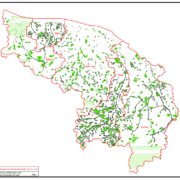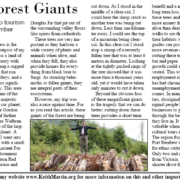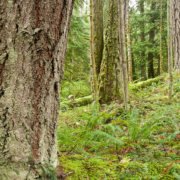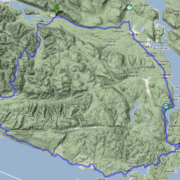The streets of Toronto were lit up by burning police cars on the weekend of June 26. But back on the Island, music fans were lighting other things as they danced to the music of Jon and Roy, Current Swell, the Racoons, DJ Tedder, Listening Party and other local acts at the first ever Tall Trees Music Festival.
Taking place in Port Renfrew, located on Pacheedaht First Nations territory, the festival was a perfect example of local bands playing for local fans, all in front of a backdrop of tall trees and eagles silhouetted against the West Coast sunset.
Tall Trees offered fans a chance to see some of the best up-andcoming musicians the area has to offer in the loose musical region of surf, folk, rock, and drum and bass/mash up DJ’s
“This festival is a beauty; one hell of a time. It was pretty bang on and I think it should be an annual thing. Just epic,” said Scottie Stanton of Victoria’s Current Swell. “There’s a lot of local talent. And you know there is that festival vibe that you just cannot pay enough for. It’s the best feeling in the world to be around a bunch of people that have the greatest energy.”
DJ Tedder, who moved to Victoria from South Africa when he was 10, agreed.
“It’s a great vibe out here, everyone is happy and friendly, good hope for next year. The setting makes all the difference. It’s a total B.C. vibe.” For Patrick Codere of Mindil Beach Markets, Tall Trees was a bit of an educational experience.
“There is so much to learn from watching other bands,” he said.
“The vibe in Victoria’s music scene is awesome. If you go to a bill of three bands at least one of them is going to be good.”
The band, who hail from the Sunshine Coast and Victoria, felt right at home tucked away amongst the trees playing folkfunk- reggae inspired music with a touch of Jurassic 5.
The festival was put on by Radio Contact, a promotional companycollective based in Victoria. Three Point Property group asked Radio Contact if they would promote and put on an event on an ocean-view bluff set for development by the company. The site, previously a campsite, was eloquently located in the belly of the San Juan Valley.
“The festival grounds seem to speak for themselves. The venue is so awesome, I love it out here. Pretty much everything I’ve heard this weekend I’ve enjoyed,” said Jon Middleton of Jon and Roy, who will be playing at Rifflandia in Victoria this fall.
As Middleton and I stood on the boardwalk talking about Victoria’s growing music scene, the hillside to the west was blanketed with beautiful first and second growth forest, while the eastern hills were juxtaposed with massive clear-cut logging. It’s a paradoxical combination of landscapes that small town B.C. culturally navigates in order to have a prosperous province. The balance between conservation and industry is an act that Port Renfrew is historically familiar with, and one that was represented well at the Tall Tree Music Festival in the contrast between the development work of Three Point Properties, and the conservation work of the Ancient Forest Alliance, who will be receiving most of the proceeds from the festival.
“Everything that we do, we try to have an benefit aspect to,” said Mike Roma of Creative Design/Radio Contact. “And in this case the Ancient Forest Alliance is interested in preserving and protecting a great portion of Port Renfrew.”
“Not only do we want to have a festival here to promote music, but also to promote the community. I think it’s been a massive success, surpassing all our expectations.” Katrina Andres, Operations Director for the Ancient Forest Alliance, said the festival was very positive.
“I had a great time and it seemed like a really successful event. I hope Radio Contact can do it annually,” she said.
Many of the musicians who performed at Tall Trees came not only to make music, but to support the area as well.
“I signed the Ancient Forest Alliance petition,” said Roy Vizer of Jon and Roy. “It’s nice that this sort of [show] brings awareness to the issues in the area. It brings a lot of money to the cause.”
Singer-songwriter Vince Vaccaro moved to Victoria from Montreal when he was 12. His music is a dreamy hybrid of folk and Xavier Rudd earth-tones. The combination of Montreal’s artistic blood, with a Zephyr muse is one worth paying attention to.
Vaccaro believes that we have a responsibility to keep our environment and our economy working together sustainably.
“Our province is our garden, and if we don’t manage it well, our jobs and industries are going to collapse,” he said. “If we don’t find a way to make logging sustainable, then we aren’t doing ourselves any favors in logging for our short-term gains.”
Vaccaro put his money where his mouth is, stepping in to help the Ancient Forest Alliance.
“I’m going to grab the Ancient Forest Alliance clip board and try and sign people up on the petition. There are only two of them, and they are really trying to not be in people’s faces too much, which is good. People are here to party,” he said smiling.







